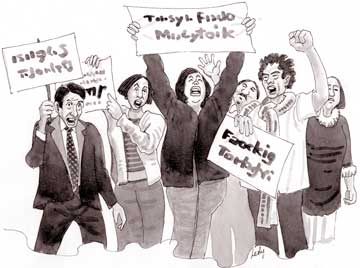Diaspora and discrimination

An interesting fact about the international community of Tamil
immigrants, which is commonly called the ‘Tamil Diaspora’, is that it
comes disproportionately from the tiny Jaffna peninsula, not from vast
and populous Tamil Nadu. This reflects in part the huge outflow from
this island following Black July 1983.
The events of that diabolical month left Tamil people (and indeed
many from the majority community) permanently scarred. Some were driven
into the arms of the terrorists and the remainder were imbued with a
feeling of not belonging in their own country.
This feeling of not belonging was exacerbated among those who fled
their motherland. The bitter-sweet taste of nostalgia for a land and a
past now gone is made bitterer by distance.
Kelaniya convention
Someone once said that the ethic chauvinism of a Sinhalese or Tamil
increases as a function of the distance that person is from Sri Lanka.
So it was among the Diaspora that a number of modern day myths and
legends have grown regarding the vexed problem of discrimination.

For example, it is quite common to blame the entire ethnic problem on
SWRD Bandaranaike and ‘Sinhala Only’. The truth is that ‘Sinhala Only’
was introduced to the State Council by JR Jayewardene and it was SWRD
who brought the amendment ‘Tamil Also’.
In 1955, SWRD’s SLFP adopted ‘Sinhala with the reasonable use of
Tamil’ but the Kelaniya Convention of the UNP espoused JR’s ‘Sinhala
Only’ policy.
‘Sinhala Only, Tamil Also’ was the country’s language canon from 1957
to 1988. The fundamental law was that a Tamil-speaker was entitled to
correspond with the government in their own mother tongue.
Official language
Breaches which occurred were, in the main, due to bureaucratic
procedure (or lack of it) rather than deliberate discrimination - public
servants were not always proficient in Tamil.
Since 1988, there has been constitutional parity of status between
the two indigenous languages, with English given the status of a ‘Link’
language. There is also a common myth that Tamil is an official language
only in the North and East. However, a glance at articles 18 to 25 of
the constitution make it quite clear that Sinhala and Tamil are equally
official languages, national languages, languages of instruction,
languages of administration and languages of the courts.
The biggest myth of all, one which is believed by many Tamils to be
gospel truth, is that there is a constitutional provision which bars
anyone but a Sinhalese Buddhist from becoming President of Sri Lanka.
That this is patently not so is proved by the fact that Kumar
Ponnambalam - as Tamil as could be - was a candidate at the first
Presidential election in 1982. However, this tends to be (somewhat
conveniently) forgotten.
National integration
This attitude, this Diasporic ghetto mindset has caused overseas
Tamils to ignore the efforts made by the present government towards
national integration, to giving life to the constitutional provisions on
ethnicity and religion.
They ignore that, for the first time a real effort is being made to
create a truly bilingual government service more responsive to the needs
of all communities.
They ignore the fact that the state is expending vast resources
clearing the minefields of the North and East and rebuilding the
obliterated infrastructure in order to make Tamil homes habitable. That
separatist fighters are being rehabilitated by the state, being given
futures where none existed before.
Genuine grievances
The Tamil Diaspora is caught up in a time-warp from which it must
escape.
This is no longer 1983.
Shortly after Tamil refugees began streaming into Switzerland, a joke
circulated that there were so many Tamils in Zurich that even the city’s
main river, the Limmat, spelt backwards sounded like ‘Tamil’.
However, over the years, the Tamil populations of Switzerland and
elsewhere proved themselves, by and large, to be good citizens. They
integrated themselves into their host communities and became Swiss or
French or Canadian. People no longer joke about the Limmat’s Dravidian
nature.
Her example illustrates how far the Tamil Diaspora has come in the
past three decades and where its future lies.
Now it is up to the Diaspora to accept that their homeland has
changed.
Meanwhile, obviously, there must be recognition on the part of the
majority community that the minorities have genuine grievances and
inalienable rights. They are not aliens, but part and parcel of one
united homeland.
The whole problem with the ‘Traditional Homelands’ dispute is that it
assumes that one ethnic group can claim exclusive rights to any part or
the whole of the country. This is the attitude which led to the LTTE’s
ethnic cleansing of Muslims from the North and to the attacks of 1983.
A separate Tamil Homeland, Tamil-only ‘Eelam’, was a dream which
became a nightmare.
Many in the Diaspora call themselves ‘Eelam Tamils’. Ironically,
‘Eelam’ has its root in ‘Sinhalam’, ‘Land of the Sinhalas’. ‘Sri Lanka’,
on the other hand, is Sanskrit for ‘Resplendent Island’ and has no
ethnic connotation.
The Diaspora should join with the government to build the Sri Lanka
Tamil homeland, an ‘Eelam’ which is not limited to the North and East,
but stretches from Point Pedro to Dondra Head.
Every part of this tiny island is the ‘Traditional Homeland’ of all
Sri Lankans, whether they be Veddha, Sinhalese, Tamil, Muslim, Malay,
Burgher, Malayalee, Bharatha, Dawoodi Bhora, Sindhi, Memon, Kaffiir or
Parsee. |



